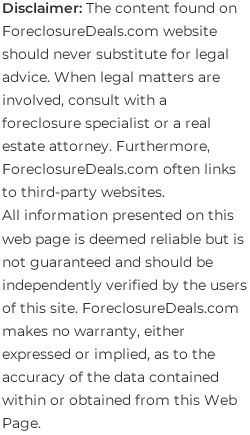Buy foreclosed houses.We have more than 1.5 Million properties available for you!
Credit Repair
The journey into debt and bad credit can be fast and chaotic or it can happen gradually over the course of several years. Regardless how your credit score fell, if you want to start the process of untangling that mess so you can start building up credit, you need a solid credit repair plan. A big part of the process will involve researching the causes of the problem and taking specific action to correct them.

Credit solutions come in many forms. For example, you may need to negotiate with your creditors or arrange for a credit adjustment loan to consolidate your debt. However, in addition to a credit adjustment loan, you might need to do a lot of digging through your personal records to verify any dispute claims you have relating to erroneous information on your report.
One thing is definitely for sure. Regaining your credit worthiness and a good credit score will require ample supplies of patience, organization and determination. Yes, there will be hoops to jump through, but the financial benefits of having a high credit score are well worth the trouble.
Get Started with your Credit Solutions now
The first step in credit repair is to assess the source of the problems that are preventing you from building up credit. You can begin with a simple credit review. Fortunately, there are plenty of credit report websites that will evaluate your credit worthiness like www.annualcreditreport.com, which are available to help with that process.
Zero in On the Negatives
Once you receive your credit report, study all the negative items on the review. This part of the process is never fun because it requires you to go back in time and look at all the different financial problems that have thus far piled up in your history. Each of those little issues is silently doing some kind of damage to your credit worthiness; therefore, it's important to know what they are so you can do whatever it takes to make them disappear.
When analyzing your credit history, look for things like:
- Bankruptcy
- Foreclosures
- Repossessions
- Loan defaults
- Court judgments
- Collections
- Past due payments
- Late payments
- Credit rejections
- Credit injuries
These are the most common items that can absolutely destroy your credit rating. Your job is to try and resolve each and every one of them. The more you can remove, the faster you will attain the high credit score you want.
Negotiating with Creditors for a High Credit Score
Now that you've identified the problem areas, it's time to get in touch with your creditors. Your creditors are eager to resolve your debt too. In fact, they are so eager that they might be willing to lower the amount you owe them just to make it happen. In other cases, there could be an error on their books that you can easily correct without paying a dime.
It's never fun to chat with a creditor, especially if your goal is to pay them as little as possible (or nothing at all). But remember, when dealing with a large financial institution, the people you're talking to are not personally angry about your failure to pay. They're just doing their job. For that reason, you can get right down to business and take your emotions out of the equation. Still, keep in mind that it really is a person you're dealing with on the other end of the phone and therefore you might be able to appeal to their humanity during negotiations.
While looking at your list of problems on your credit report, try and tackle what is easy to remove first. Problematic credit issues to avoid while taking care of the easy stuff would be topics like foreclosures, child support, or any other types of judgment. Some of the easier things include the following:
- The account is not yours
- You had no late payment
- Incorrect amount
- Incorrect account number
- Incorrect original creditor
- Incorrect charge-off date
- Incorrect date of last activity
- Incorrect balance
- Incorrect credit limit
- Incorrect status
- Incorrect high credit
While a lot of the above are self-explanatory, some require a bit of explanation. For example, the "charge-off" date is the date that your creditor removed your delinquent account from their "accounts receivable" and moved it to their "bad debt ledger." Depending on your state of residence, if a certain amount of time has passed after the charge-off date, then your debt is no longer legally collectible. For that reason, an incorrect charge-off date can be an excellent dispute to resolve because it could erase thousands of dollars of actual debt in the blink of an eye. Next, the "high credit" figure is what the highest amount you owed the creditor was. If it is reported that your "high credit" amount was at one time above your credit limit on a certain card, then it can be problematic for your good credit score.
Contact the Credit Reporting Agencies
After you resolve a problem area on your credit report, contact the credit reporting agency (CRA) or agencies that are reporting the bad credit information. Also contact them if your creditor isn't seeing your side of the story, but you have sufficient written documentation to prove something should be removed.
Whenever you get in touch with a CRA, send a letter by mail and make sure you send it Return Receipt. Since CRA's are required by law to respond in a timely fashion, it is important for you to maintain a record of what you sent them and when you sent it. That way, if you have any kind of problems getting an answer, you can put more pressure on them to respond.
CRA's are required to resolve a dispute within 30 days. However, if you have used www.annual creditreport.com, then the CRA will have 45 days to respond. In cases where a creditor ignored your supporting evidence, the CRA must consider your case and resend the creditor your documentation. You will receive the results of the investigation along with your updated credit information in writing within five days of its completion. After something has been cleaned off your record, the CRA can't put it back on without giving you at least five days advanced notice.
Analyze the Results and Follow Through
After your dispute has been handled by the CRA, there may be some issues that were not appropriately taken care of. For example, the status of one of your disputed items may not be listed in the CRA's results list. In such cases, you may have neglected to include the issue in your dispute letter, or your request wasn't clear enough. Either way, it will be necessary for you to send another dispute letter that addresses that item.
Also, the CRA might have investigated your disputed item, but verified its authenticity and therefore it remained on your report. In such cases, you probably will not get a detailed explanation aside from the CRA saying "item verified." But don't let this discourage you. It's likely that the CRA used a computer-automated system called eOscar to investigate and transmit your information to the creditor; however, the eOscar system is not without its flaws. With eOscar, credit report disputes get categorized into 1 of 26 classifications, which is far from efficient. Each case is unique; therefore, if the results of your investigation are not what you wanted, follow through and request they provide you with the "Method of Verification" employed. Another credit improvement strategy would involve resubmitting your dispute later. Indeed, if another employee reviews your file, you may receive the benefit of a different opinion that gets you one step closer to a high credit score.
Finally, the results of the CRA's investigation of your credit information could include an item marked "unverifiable." This could result from the creditor's failure to respond to the CRA or the creditor just wasn't able to verify the listing. Both ways, it's an excellent outcome, which will cause the malicious listing to be removed and result in an overall credit improvement for you.
Check your Personal Information
One final thing that could be causing a ruckus on your report is your personal information. You might find erroneous information related to:
- Names and Aliases
- Addresses
- Social Security Number
- Date of Birth
- State ID Number
- Spouse Information
- Employers
If the problem with the information is simply that it's old, but it actually belongs to you, then it shouldn't be causing any trouble. However, if there is erroneous personal information on your report belonging to someone else, then it might cause negative items to appear on your credit report relating to another person. Since the CRA verifies items on your credit report by comparing it to your personal information, if you resolve the problems with your personal information, it will simultaneously resolve the items that don't belong to you.
Best of Luck with your Credit Solutions!
You have embarked on a difficult journey toward credit improvement and financial redemption. Once you have removed the black spots from you record, then you can begin taking steps to manage your finances in a way that is building up credit rather than destroying it. The financial savings and convenience that come from having a good credit score are well worth the effort, so keep your goals in mind, remember to follow through with your plans, and most of all, enjoy the fruits of your credit repair success.
How to Buy Foreclosure Homes: Beginners Guide
Along with giving you tips on how to buy foreclosure homes, this video explains the foreclosure process, the foreclosure laws and the benefits of buying a foreclosure to first-time homebuyers. Among these tips are pre-qualifying for a loan, hiring...Find Foreclosed Homes for Sale in the Most Active States
- California
- Florida
- Texas
- New York
- Michigan
- Arizona
- Illinois
- Georgia
- North Carolina
- Nevada
- Pennsilvania
- Colorado
Find Foreclosed Homes for Sale in the Most Active Counties
- Broward, FL
- Queens, NY
- Westchester, NY
- Dade, FL
- Santa Clara, CA
- Palm Beach, FL
- Wayne, MI
- Clark, NV
- Harris, TX
- Tarrant, TX
- Maricopa, AZ
- Cook, IL
Find Foreclosed Homes in the Most Active Cities


